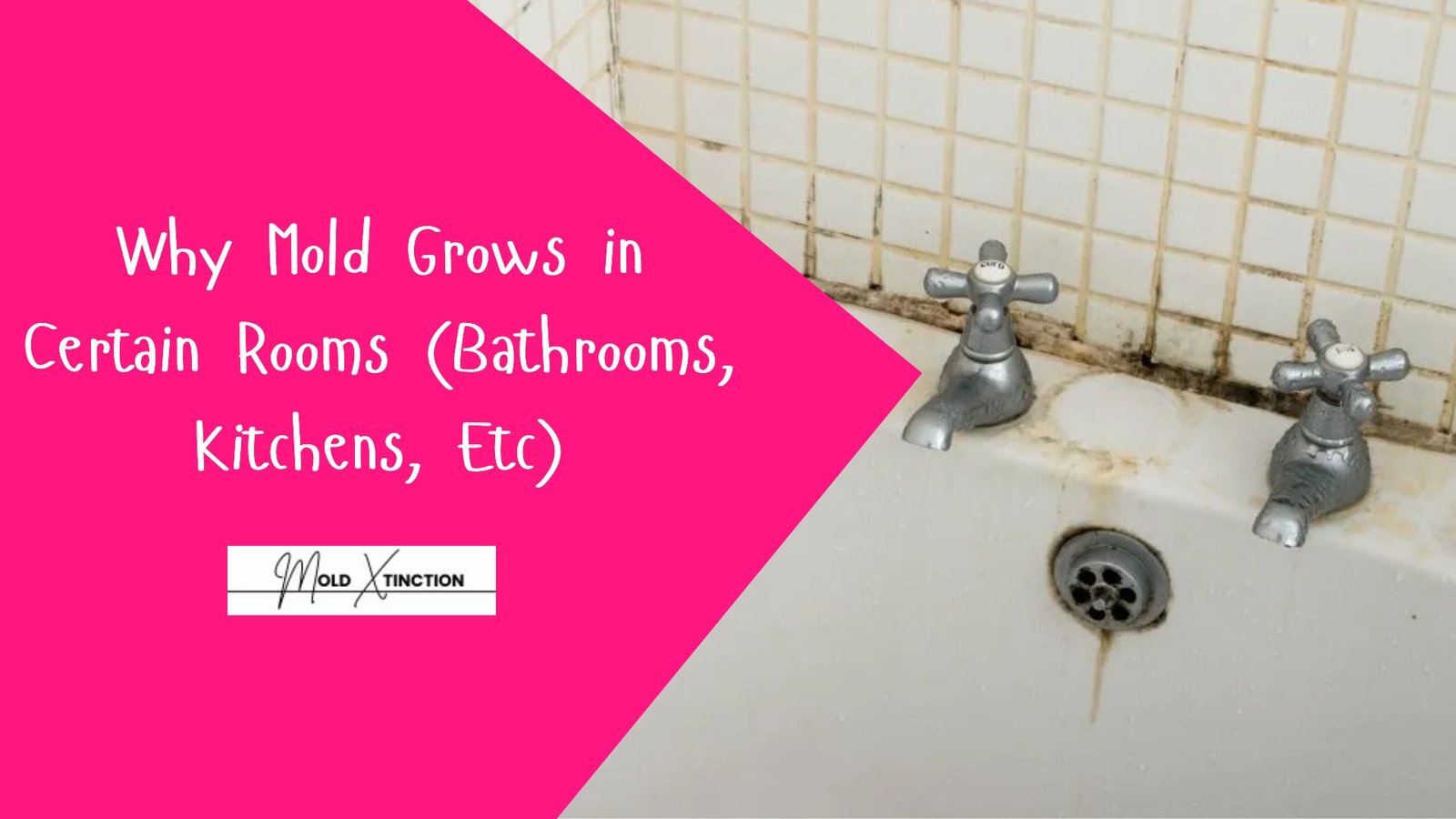Steam and heat are some of the reasons why mold grows in certain rooms like the bathrooms, kitchens & more.
I remember Angelina, she wrote an email to us a few months ago. In a summary of what she told us, we realized how worried and concerned she was because of the presence of mold in her house.
Do you know what shocked us the most? Is when she said she also had mold in her bedroom.
But we also noticed that she shot herself on the leg because she was not helping the situation; she was more than careless till mold grew to the extent of entering her room.
She used to hang her wet clothes somewhere in a corner and her windows never open during the day and she doesn’t even have a fan or air flow.
It’s like most of us who didn’t realize that even the small habits we have in our daily lives can open the doors to mold in the very places that seem like the safest.
I recommended her the same regimen as what’s in this post and within weeks she wrote back to me that she got rid of the mold and her room smelled fresh again.
So you can always ask yourself, why would that mold be in rooms? Well, read on. Or you may be doing the same thing.
What's In This Article
ToggleWhy Mold Grows in Certain Rooms (Bathrooms, Kitchens & More)

All that’s needed to grow mold is the presence of three factors:
- Water (steam, spillages or leaks)
- Heat- most mold will grow faster when it’s warm
- Food- dust, fabric, wood, old soap is all food to mold
All these are present in some rooms of your home. That’s why you will find mold in places such as:
- Bathrooms
- Kitchens
- Laundry rooms
- Bedrooms
- Basements
- Closets
- Attics
Let’s look at the mushrooms in these rooms individually and why it’s in love with them.
Mold in Bathrooms
In most houses, the bathroom is the top location of mold.
Every time you take a bath or shower, the bathroom becomes warm due to the steam. Unless that steam can release, then it becomes humidity on walls, mirrors and ceilings and the start of fungi will be present.
Sinks and toilets are in the bathroom and they may also leak but you’re not aware.
Common Places Where Mold Grows in the Bathroom:
- Behind and under the sink
- At the bottom of the toilet
- Ceiling by the shower
- Corners of the tub
- Grout tile* On bath mats and shower curtains
Windowless bathrooms are even more deadly. Just keep in mind that mold will always be in a dark, secret environment that no one visits.
Kitchens
Aside from the bathroom, which we just discussed above, you will also find mold in the kitchen as well.
Here’s the thing, you wash dishes, boil water, cook food and sometimes spill something. All these activities increase the humidity of the room.
If your kitchen is not maintained clean or there’s bad air circulation, then mold can grow fast and sometimes even without you noticing it.
Where Mold Hides in the Kitchen:
- Under the sink
- Behind the refrigerator
- Off the dishwasher
- N or behind cabinets
- Inside pantries
- Kitchen window vents
Don’t forget food, too. Mold loves discarded food crumbs, or food smears, or even wet sponges in the sink.
Laundry Rooms
Laundry rooms are wet, hot and have cloth so mold loves it.
Moisture can get trapped in your washing machine and its hoses and the heat of the dryer, which allows it to grow into a mess.
Where to find mold in the laundry room:
- Behind the washing machine
- Dryer vents kör„ warning signs
- Laundry baskets
- Closets or inside cabinets
- Walls and floors near a hosepipe
Some laundry rooms are in the basement and these areas tend to be more humid so there’s a higher chance of mold growth in the laundry room.
Bedrooms
You may not consider the bedroom as a mold hotspot but mold can still grow in a room with:
- Poor ventilation
- Attached bathroom
- Indoor plants
- High humidity
Mold can start to grow if there’s not enough air flow in the room. Humidity can increase because of night sweat and breathing.
Where Mold Grows:
- Around windows
- Inside closets onawaitwalls
- Behind furniture
- Window sills
- Under carpets
Pillows, mattresses or even curtains can also be a mold growth place if they are wet.
Basements
Basements are the wettest in a house.
A hole is dug on the ground so that water on the ground diffuses through the walls or floor. When the basement has not been water proofed or provided with ventilation systems, then water gets trapped there and within a short time, molds may grow there.
Under what conditions does mold grow in basements?* Cemented plasters
- Storage boxes behind
- Timber beams
- Sump pumps
- Basement furniture
Some people don’t check their basements in their homes. This allows mold to grow for months and go unnoticed.
Mold in Other Areas
Mold can grow in places you can’t see such as:
- Closets: Especially if you have wet shoes or clothes!
- Attics: A poor insulation or leaking attics may result in the accumulation of moisture in attics.
- Garages: Rainwater shower, bad ventilation in air or moist equipment can cause mold growth
- Air vents: Moulds can grow in air vents due to condensation and this can spread to the entire house.
What Makes Mold Grow in the First Place?
Now, let’s talk about the main issues that make mold grow in the household:
- Leaks: Sinks, pipes, roofs or appliances
- Stagnant air: No way out for humid air to dry out
- High humidity: Mold feeds on more than 60% humidity
- Damp things: Shirts or blankets or rugs
- Flooding: Un-cleaned up flood damage
- Condensation: On cold windows, walls or pipes
Clutter: Paperwork, boxes, clothing are known to hold moisture and areas where mold can hide and out of sight and out of mind
Signs You Might Have Mold
Mold can be visible sometimes. In other times, you just see the signs.
These are some signs to look out for:
It smells swampy to cross the road, dearie, you might have caught a cold, you might have caught a cold, dearie, cross the road as you like, but dash through the swamp, dearie, over to the rafters, and say your prayers as you like, you might have caught a cold, you might have caught a cold, dearie, cross the road as you like as you like, but dash through the swamp, dearie, over to the rafters and say your prayers as you like, you might have caught a cold, you might have caught a cold,
- There are spots on bare walls or ceiling
- Your wallpaper (s / your paint) is bubbling
- You have more coughs and sneezes at home
- You see patches of black, green, gray etc.
- There are water damages or previous water overflowsCross the road!
What to Do to Prevent Mold in the House
Good news is you can prevent mold before it appears.
Here are the steps to maintain a mold free house:
1. Air Your Home
Open windows especially in kitchens and bathrooms. Open windows or vents to air it out.
2. Plug Leaks Fast
And stop ignoring dripping faucets and leaking toilets and roofing problems. Any leakage whatsoever can fuel moulds
3. Use Dehumidifier
If you find your room or any part of your house is too humid or stuffy, one of the best options is to make use of a dehumidifier. What this will do is to help you take the excess moisture out.
4. Dry and Clean Wet Things
Wet clothes, towels or rugs should not be left anywhere to dry. Wet them on paper and dry them off in a short time.
5. Clean It Every Day
Of course, where dust or dirt exists, mold will have the privilege of growing because that’s its survival environment.
6. Store Things Right
Things should not be stored in wet boxes or cupboards. Plastic bins and keep things off the ground.
7. Secret Sites
Look behind furniture, under sinks and around windows and check for any moisture or mold there.
Never Try to Remove Mold Yourself
You may think it’s easy to clean mold, one just needs a sponge and some bleach, right?
Wrong Approach…
Bleach can eliminate the visible molds on a surface but it won’t kill the roots. And if you clean mold you may spread spores in the air – which can worsen the situation and affect your health.
Plus mold can grow behind walls or beneath floors and you can’t see it. That’s why amateur cleanup is not an option for anything above a small patch.
Call a Professional Remediation Company
If you feel there’s some mold in your house then the best thing to do is to call one of those professional mold remediation companies.
They will:
- Inspect your whole house
- Detect hidden mold patches
- Safely remove all the mold
- Remove excess moisture issues
- Help you to keep your home mold-free
Professionals have the tools, training and protective equipment to do the job and do it right- confident that they won’t spread mold and protect your household’s health.
📞 Contact Us
Conclusion
Mold will grow where it’s allowed – not by chance and the rooms it chooses are usually the rooms we neglect, the wet bathroom where someone just took a steamy shower, the kitchen where a leak is hidden, or the laundry room where the clothes have been sitting too long.
It not only damages surfaces but air quality, health and peace of mind. That’s why prevention is key and acting fast is most important after an outbreak.
Surface cleaning won’t help mask the problem but only to make sure mold is treated professionally. Act now!
Helpful Guide: Can Mold Cause Skin Rashes or Hives?


